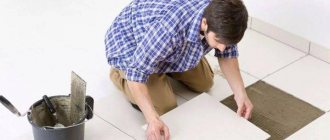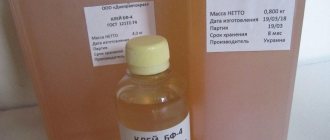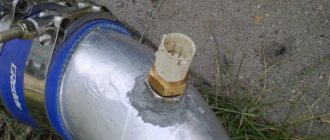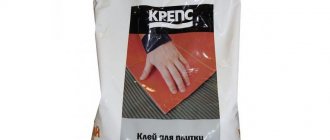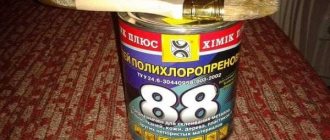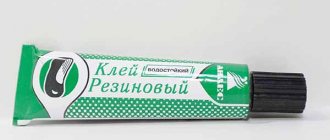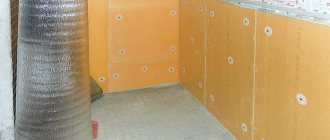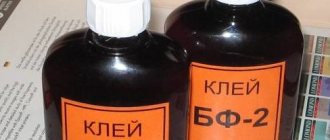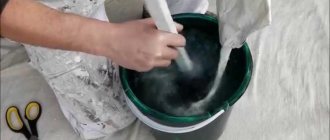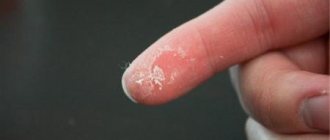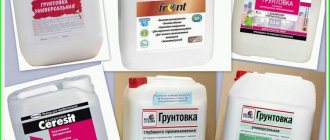Specifications
Plitonit tile adhesive is used for laying ceramic, porcelain stoneware, clinker slabs on horizontal and vertical planes with any base.
Technical characteristics of Plitonit:
- Plitonite is produced in three series: a, b, c. Packaging is carried out in bags of 5 and 25 kg.
- The contents of the bags are a dry, gray powdery mixture. To prepare the solution, you need to dilute the powder with water according to the instructions.
- The mixture contains cement, binders, adhesive components, modifiers, and fillers.
- Powder grains no more than 0.63 mm.
- The finished solution is plastic, which makes it possible to hold the tiles on a vertical area without slipping.
- It is permissible to form a glue joint up to 10 mm.
- Commissioning of the tile cover is permissible no earlier than one day later.
- Temperature conditions when applying the layer are 5–30 degrees, during operation – +60 degrees.
- Adjustment of the tile layer is permissible within 15 minutes; the finished solution requires consumption within 4 hours. After the expiration date, the mass will lose its properties and will not provide the required adhesion.
- Service life 12 months.
View this publication on Instagram
Publication from SKS Construction Trading House (@std_sks_spb) July 23, 2021 at 5:34 PDT
Tile adhesive Plitonit: types
Products of the Plitonit brand are classified according to the solution’s resistance to moisture and are produced in several modifications.
1. Plitonite A.
This type of adhesive is created for all types of ceramic tiles with water absorption from 1%, dimensions no more than 30x30 cm.
2. Plitonite V.
This type of Plitonite, which can be bought at a hardware store or ordered online, is used indoors and outdoors.
Plitonite (tile adhesive) A and B is used for cladding surfaces made of reinforced concrete (reinforced concrete), concrete, brick, gypsum plasters, lime-cement bases, on cement surfaces, cellular concrete bases.
Features of Plitonit A and B glue:
- suitable for covering heated floors;
- can be used as a masonry mortar when installing slabs and blocks made of gas, foam, cellular concrete, sand-lime brick;
- used in any type of premises;
- has increased water resistance and ductility;
- holds well on a vertical surface.
3. Plitonite B mosaic.
White tile adhesive Plitonit, created for tiling surfaces with mosaics.
Characteristics:
- can be used for fixing stone, ceramic, glass, decorative mosaics, small-format marble tiles;
- has adhesion of 1 MPa;
- Designed for indoor and outdoor work.
4. Plitonite Bprofi.
Designed for covering the floor with any type of ceramic tiles, porcelain stoneware (up to 45x45 cm) indoors and outdoors. In addition, the composition can be used when installing mosaic tiles of dark colors.
5. Plitonite Bpro.
Designed for surface cladding:
- porcelain stoneware (size up to 45x45);
- ceramic tiles;
- dark mosaic tiles.
General characteristics of Plitonit Bpro and Bprofi glue:
- forms high-quality adhesion;
- easy to use;
- used in the process of cladding surfaces made of reinforced concrete, cellular concrete, gypsum plasters, bricks, plasterboard bases, plasterboard, tongue-and-groove slabs, etc.;
- ideal for installing tiles on indoor pools, balconies, terraces, plinths;
- can be used for cladding ceilings with mosaic tiles;
- used in underfloor heating systems.
6. Plitonite B maxislayer (thick-layer adhesive).
Used for covering surfaces with any type of tile.
Characteristics:
- used for fixing relief-shaped tiles of different thicknesses, as well as large-format building materials;
- creates simultaneous leveling of the surface and its cladding;
- has increased adhesion and plasticity;
- recommended when creating a heated floor system;
- used for cladding indoor pools, plinths, terraces, balconies.
7. Plitonite V.
Designed for covering surfaces with any type of tile.
Characteristics:
- fits perfectly on a vertical surface;
- can be used for installing tiles in underfloor heating systems, as well as swimming pools;
- used on a variety of surfaces;
- It is characterized by high plasticity, frost and water resistance.
8. Plitonite C is light.
This type of Plitonite, the price of which can be checked on the Internet, has low consumption and is designed for tiling complex surfaces with any type of tile.
Characteristics:
- has excellent adhesion;
- in comparison with other compositions it has 40% less consumption;
- recommended for facing complex surfaces;
- he is easy to work with.
READ MORE: Sauna 117 photos beautiful designs of a bathhouse in a private house with a hammam layout with a shower how to choose a thermometer reviews
9. Plitonite C marble.
White adhesive designed for glass, mosaic and marble tiles.
Peculiarities:
- has increased plasticity;
- excellent adhesion;
- does not form limescale;
- does not change the color of the tile;
- Recommended for lining swimming pools and heated floors.
10. Plitonite S.
Created for cladding complex surfaces (cement-bonded particle boards, bases painted with alkali paints, lined with old tiles, coated with alkali-resistant adhesives) with any type of tile.
Peculiarities:
- used for heated floors, swimming pools;
- can be used as an intermediate layer when carrying out putty and plastering work;
- differs in frost and water resistance;
- has good ductility.
11. Plitonite Wb.
Fast-hardening building material for all types of tiles.
Peculiarities:
- this type of glue is used when there is a need for urgent commissioning of the premises;
- has excellent adhesion to the surface;
- increased frost and water resistance;
- convenient to use.
12. Plitonite-AquaBarrier HydroGlue.
Peculiarities:
- used for lining various water tanks with glass, porcelain, mosaic tiles, etc.;
- has increased resistance to chlorinated water;
- does not change the color of the tile;
- recommended for contact with drinking water;
- has increased elasticity.
13. Plitonit-SuperFireplace ThermoGlue (W).
Heat-resistant adhesive with reinforcing fibers. Created for lining fireplaces and stoves.
Peculiarities:
- in addition to its direct purpose, it can be used as a grout, putty;
- has increased adhesion;
- multifunctional;
- has strength.
Advantages and disadvantages
Among the advantages of using plitonite adhesive mass, the following are highlighted:
- The solution does not require special preparation; the dry mixture mixes well in water without forming lumps.
- Increased adhesion.
- Low level of slip coefficient from the vertical plane.
- The flexibility of the layer allows you to hold the tiles, preventing cracking when the building shrinks.
- Moisture and frost resistance allows work to be carried out from the street side.
- Availability.
Negative points include:
- The base must be carefully prepared before laying, otherwise the tile layer will move away from the surface.
- The minimum packaging is 5 kg, so you will have to overpay for an unnecessary amount of glue.
Consumption rates
The average consumption per 1 m2 of Plitonit glue may vary depending on various factors. It is 1.7-5 kg/sq.m. m and is determined by the following indicators:
- tile size (the larger it is, the greater the consumption due to increased layer thickness),
- tile material (tiles absorb more glue than ceramics),
- the evenness of the base and the quality of its preparation (more glue will have to be applied to uneven surfaces),
- method of applying the solution (solid or notched trowel),
- master skills (beginners often allow glue to be lost, the adhesive layer to be uneven, etc.).
Preparation of mortar mixture
The condition for preparing the solution is room temperature of the driest mixture of plytonite and water. If the bag was stored or purchased in cool weather, then before use it should be kept warm for up to two hours.
The solution is made from purified water without chemical compounds, which is poured into a container with a cleaned bottom and walls. It is forbidden to knead in a dirty container or with dirty tools. If a construction mixer is used, then the attachment is new or cleaned from the previous batch.
According to the instructions, for one kilogram of dry Plitonit glue you need 240 ml of water. That is, approximately 6 liters of water are consumed for a 25 kg bag.
Initially, water is poured, and then the dry mixture is poured.
To check whether the solution has been prepared correctly, apply it to the wall; if there is no dripping, then the consistency is correct. The stirred mixture is left for 5 minutes to swell, then mixed again. Throughout the work, the mixture must undergo additional mixing.
Useful video on the topic:
Work order
The work is carried out under the conditions prescribed by the manufacturer (at a temperature of 5–30 degrees), then the layer will dry evenly, ensuring complete adhesion. Put the tiled surface into operation no earlier than one day after installation. This also applies to grouting work.
The tile material is completely cleaned from the working side. The coating that is covered with tiles should not contain unevenness, old material, deformation is excluded.
The surface is puttied to remove cracks and crevices, then primed. It is advisable to buy the primer of the same brand as the adhesive mixture. If the room is damp, then the primer should contain antiseptics and antifungal components.
Subtleties of application
When working, there are subtleties that should be taken into account:
- The adhesive is spread on the tiles using a notched trowel.
- You should not apply the adhesive mixture directly to a large surface area, as the formation of a dry film will reduce the quality of adhesion.
- The same distance must be maintained between the tiles (crosses must be placed); adjustments to the location are carried out within 20 minutes.
- Excess should be removed immediately after adjustment to avoid later scraping from the face of the tile.
- When laying large tiles or on a “warm floor” system, the application is combined, the solution is applied to the tile and the main surface.
- Use is prohibited within 24 hours after installation.
- The work is carried out subject to the availability of IZ funds.
- If the solution gets on exposed skin or mucous membranes, rinse with running water.
Interesting video on the topic:
Technological requirements when working with Plitonit glue
In order for the repair to be carried out efficiently, it is necessary to perform sequential actions when laying tiles.
READ MORE: Washing machines with two drums, features of double-loading machines Double-chamber models Advantages and disadvantages of equipment with 2 drums
Preparation
Plitonit B glue must be applied to a strong, even, strong base that is not subject to deformation. It is recommended that the working surface be thoroughly cleaned of various types of contaminants: debris, dust, dirt, old coating (glue, paint, wallpaper, etc.), grease. Slots and cracks are sealed with putty, and after that the working surface is treated with a primer solution.
If the coating has a loose structure, then it needs to be primed in 2 layers. Floors are also treated with a special compound to prevent mold from forming under the tiles, this is especially necessary for bathrooms.
Preparing the mixture
Before you start preparing the tile mixture, you need to take into account certain recommendations.
- All components used must be at room temperature.
- For mixing, tools and containers that are completely free of contamination are used. If they have previously been used to prepare the mixture, then the remaining solution must be eliminated. They can affect the properties and qualities of the freshly prepared composition.
- To make it easier to pour the mixture into the container, you can use a trowel.
- For kneading, use only clean water, preferably drinking water. Technical fluid may contain alkalis and acids, which will negatively affect the quality of the finished solution.
For 1 kg of dry mixture you will need 0.24 liters of water, respectively, for 25 kg of adhesive you need to use 6 liters. Water is poured into a suitable container and the dry mixture is added. Mixing takes about 3 minutes, you can use a mixer or a drill with a special attachment, the main thing is to get a homogeneous consistency without lumps. The readiness of the mixture is determined in such a way that when applied to a vertical surface it does not drain.
The finished mixture is set aside for 5 minutes, after which it is mixed again. In some cases, it is possible to add water, but it is not recommended to exceed the values indicated in the instructions.
Subtleties of application
- Plitonit B adhesive is applied using a smooth spatula in a thin, uniform layer. The coating of the adhesive solution must be given a comb structure for better adhesion to the tile.
- If a dried crust has formed on the surface of the applied solution, the layer is removed and replaced with a new one. The tile is placed on the glue and pressed into the mixture with gentle turning movements. The position of the facing material can be adjusted within 20 minutes. When installing tiles, it is recommended to use a laser level.
- At the end of the work, excess adhesive solution is removed from the tile seams. Peeling is done with a knife until the mixture hardens. The front side of the tile is cleaned of dirt with a rag or sponge soaked in water or a special solvent.
- When tiling floors with a heating system, as well as laying large tile materials, in order to avoid the appearance of voids under the finished coating and to increase adhesion, experts recommend applying adhesive using a combined method. The composition is applied both to the prepared base and to the back side of the tile. Apply the adhesive to the tiles using a notched trowel, and then use a smooth trowel to level the layer.
You can often hear the opinion that you can walk on the tiles on the floor without waiting for the glue to completely dry. This is strictly prohibited because:
- if the adhesive solution has time to dry, but has not gained maximum strength, then there is a high risk of the masonry shifting;
- Damage to the tile material may occur, especially in areas where voids have formed due to insufficient mortar applied.
- The surface must be clean, strong, and dust-free.
- Before applying glue, the base should be cleaned of oil and cement glue.
- When working with glue on a concrete surface, the latter should not be subject to shrinkage.
- Glue consumption varies from 3-5 kg per 1 m2.
- All compositions of the Plitonit brand are applied at a temperature of 5–30°C.
- If the glue belongs to the standard category, then after its application the surface can be walked on only after 24 hours.
READ MORE: Heat-resistant adhesive, high-temperature composition for stoves and fireplaces, heat-resistant and fire-resistant adhesive for glass and tiles
